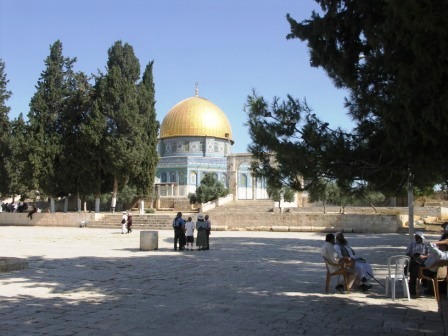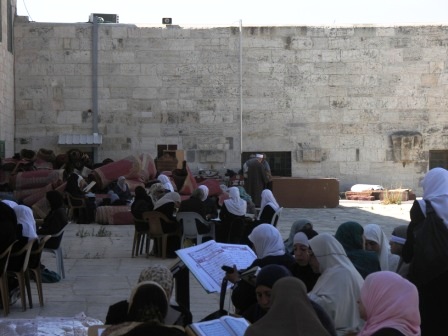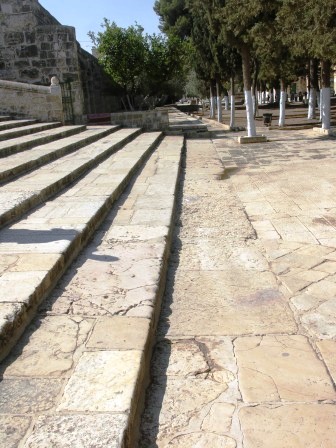by John Strong
June 26, 2011
I’m back in Jerusalem this weekend for a little touring. My main objective, besides lingering at breakfast over too much coffee and an extra roll with jam and butter, is to visit the Temple Mount. This place still fascinates me, and I am continually drawn there.
First, a few definitions. The Temple Mount is the platform on which Herod’s temple stood. This is the temple destroyed by the Romans in 70 ce. The thoroughness of the Romans’ destruction can be seen in the archaeological park below, where the stones that they cast down are still imbedded in the broken pavement below. Herod’s temple was only finished in 63 ce, after being under construction for about 80 years or so. This temple was a massive refurbishment of the earlier, “Second” temple, initially built during the days of Zerubbabel, Jeshua, Haggai, and Zechariah, around 516 bce. And this Second Temple was the replacement of the First Temple, built by Solomon around 950 bce or so.
Back to modern times, all that remains of Herod’s temple is the imposing platform on which the temple building and precinct itself was situated. Today, the Dome of the Rock and the Al-Aqsa mosque are located on this platform, and mark the place of Muhammad’s night journey (see Sura 17 in the Quran), and thus, the third most sacred place for Muslims. The Western Wall (which some may know as the “Wailing Wall,” a term not really appreciated by Jews) is just below, at the western base of this platform. The Temple Mount, while located in Jerusalem and in Israel, it is administered by the Waqf, a Muslim foundation that maintains this sacred precinct.

When entering the Temple Mount, you first have to go through security, pretty much like you do when you go through security at an airport. While waiting in line, it is interesting to read the signs, warning the visitor that no one knows where the Holy of Holies actually was, and that conservative Jews do not go to the Temple Mount because they may actually step on the place where according to the ancient Hebrews, Yahweh’s throne sat. I have Jewish friends who have never visited the Temple Mount for this very reason. Nevertheless, many Jews, Christians, and Muslims enter onto the Temple Mount, and I was pretty happy to be one of them this particular Sunday morning.
Now, once on top, I must admit that the thing that strikes me most odd about the sight is that in the midst of this holy place, there are heaps of garbage piled in places around the grounds. This is because it is a working piece of property, and people produce trash. So, it has got to go somewhere, and I suppose the eastern side of the temple grounds amidst the olive trees and the pine trees is as good a place as any.

Plenty of other people are up on the Temple Mount. There were groups of Muslim women seated together talking beside the Al-Aqsa Mosque. Christian tour groups were taking pictures of various members with the beautiful blue and gold Dome of the Rock in the background. I was offered to be given a guided tour by several different Arab entrepreneurs. And a few young boys were out selling postcards. Apparently the Temple Mount is a place of commerce today, just as it was in Jesus’ day (recall the gospel stories about Jesus throwing out the money changers).

I have to admit that I was on a mission. I wanted to photograph a particular set of stones. There is an architect who specializes in archaeology who has argued that there remain a few select stones from Solomon’s temple. These, he says, actually formed the corner of the 500 by 500 cubit temple platform for this First Temple. I walked straight to this corner and took a look. Well, the stones were really old, and they were huge, and what this guy suggested could have been true. So, I took my pictures and moved on.

More could be said about the Temple Mount. The Temple Mount just fascinates me, as do passages and the theology of the First Temple discussed in the Hebrew Bible. I’m always grateful for the opportunity to visit this sacred space to Muslims and Jews. I just try to be careful on whose toes I might be stepping.
